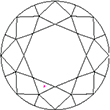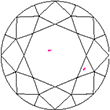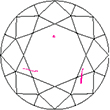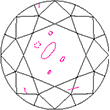Diamond Buyer's Guide
Diamond Cut
Considered the most important of the 5Cs, diamond cut refers to two important aspects of the diamond. First, "cut" is used to describe the shape of the diamond, whether it's round, princess, radiant, marquise or any of the other commonly seen shapes.

The second usage is how the diamond is physically cut. This "cut" gives the diamond its brilliance and sparkle – how light is reflected, dispersed and scintillated. Unlike color and clarity, there is not a single grade that defines it. Furthermore, two diamonds equal in carat weight, color and clarity can differ in appearance and value because of differences in cut quality.

The cut is the most complicated of the 5Cs. Unlike carat weight, color and clarity, whose value and rarity are related to the diamond's natural formation, cut quality is the result of human decision and diamond cutting skills.
There are three factors that determine a diamond's cut quality:
- Proportions: the relative sizes and angles of the diamond's parts and facets
- Symmetry: the precision of the cut design, especially the facets
- Polish: the smoothness and lustre of the diamond's surface
Cut grades are referenced on a diamond's certificate often using the GIA standards of Excellent, Very Good, Good, Fair and Poor. The quality of a diamond's cut always speaks for itself.
Diamond Clarity
Simply stated, clarity is a measure of the tiny imperfections found in most every diamond.
A flawless diamond with little to no imperfections is often desired due to its rarity, but they are also the most costly. Therefore, it is important to keep in mind that it is very common for diamonds to be formed with slight imperfections.
These imperfections are known as "inclusions" and usually occur during the diamond's crystallization period within the earth, or from the stresses of mining and processing. Inclusions are anything from tiny white points to dark dots, cracks or scratches. The fewer inclusions, the more valuable a stone is. Clarity is evaluated using a 10‐power magnification. This means that the object viewed appears 10 times its actual size. The diamond grader examines the clarity characteristics with respect to the nature and number of characteristics, as well as their size, colour and position. The clarity grade assigned reflects the degree of visibility of the characteristics.
The GIA Diamond Clarity Grade scale has five main categories of clarity characteristics with 11 grades in all.
The FL Grade (Flawless)
The term FL or flawless is used for diamonds in which a qualified observer, under favorable lighting conditions, cannot find internal characteristics and/or faults by thorough examination with a 10X loupe.
The IF Grade (Internally Flawless)
A diamond which has no internal characteristics but which, due to minor finish faults, is not flawless and therefore cannot be designated FL or flawless, may be called IF or internally flawless provided the finish faults are so minute that they can be removed by a gentle polishing with only an insignificant loss of weight.
The term VVS is used for diamonds with internal characteristics very, very difficult for a qualified observer to find under observation conditions as described. Further, there may only be insignificant finish faults.

The term VS is used for diamonds in which it is difficult for a qualified observer, under observation conditions as described, to find either a few somewhat larger internal characteristics or several very small ones.

The term SI is used for diamonds in which a qualified observer may, without difficulty, under observation conditions as described, find internal characteristics. Further, there may only occur single finish faults of an insignificant kind.

The term I or imperfect is used for diamonds in which a qualified observer, with the naked eye, can see internal characteristics and/or in which such major faults occur, which substantially reduce the value of the stone.

Only about 2% of the world's diamonds are actually flawless. Most retail stores carry VVS as their highest grade. VS or SI are considered by most to be "fine quality" diamonds.

There are two type of flaws that a diamond can have – external and internal. External refers to flaws that may be visible on the outside of the diamond. Internal, of course, refers to flaws that may be visible on the inside of the diamond. When looking at a diamond through a loupe, your Jewellery Consultant may point out certain flaws. These flaws are essentially the diamond's fingerprint and may include:
| External Flaws | Internal Flaws |
|---|---|
| Natural – unpolished surface; the original 'skin' of rough diamond | Included – inclusions within diamond |
| Cleavage or feather – inclusion along atomic grain | Carbon spot – included crystal |
| Pit – small indentation on a flat surface | Grain/twinning – irregularity in crystal |
| Fracture – irregular shaped break | Pinpoint – small included crystal (appears white) |
| Cavity – a opening on the surface | Cloud – group of pinpoints |
| Nick – Minor surface chip | Internal grain line – visible part of internal grain structure |
| Scratch – small groove (can be due to wear and tear) | Bearded or feathered girdle – minute to small hairline fracture extending from girdle into stone |
| Chip – Broken along eternal edge | |
| Laser drill hole – clarity enhancements to remove or reduce the appearance of inclusions |
The clarity grade of a diamond not only affects the value and price, but can also be a good indication of the diamond's vulnerability. Heavily included diamonds can be prone to breakage.
Diamond Carat Weight
Carat weight is the easiest to understand of the Cs. A diamond's weight is measured in carats. The carat is subdivided into 100 equal parts called 'points.' One point equals .01 carat or 1/100 carat. A half‐carat diamond is 50 points. A one carat diamond equals 100 points.
Carat weight may be expressed in both fractions and in decimal numbers. Diamond weight fractions are approximate and refer to ranges of weight.
| Fraction | Carat Weight | Fraction | Carat Weight |
|---|---|---|---|
| 1/10 ct. | 0.085-0.11 | 1-1/4 ct. | 1.23-1.28 |
| 1/8 ct. | 0.115-0.14 | 1-1/3 ct. | 1.29-1.36 |
| 1/6 ct. | 0.145-0.17 | 1-1/2 ct. | 1.45-1.57 |
| 1/5 ct. | 0.18‐0.22 | 1-5/8 ct. | 1.58-1.68 |
| 1/4 ct. | 0.23-0.28 | 1-3/4 ct. | 1.69-1.79 |
| 1/3 ct. | 0.29-0.36 | 1-7/8 ct. | 1.80-1.94 |
| 3/8 ct. | 0.37‐0.44 | 2 ct. | 1.95-2.11 |
| 1/2 ct. | 0.45‐0.57 | 2-1/4 ct. | 2.23-2.28 |
| 5/8 ct. | 0.58-0.68 | 2-1/3 ct. | 2.29-2.36 |
| 3/4 ct. | 0.69-0.79 | 2-1/2 ct. | 2.45‐2.57 |
| 7/8 ct. | 0.80‐0.94 | 2-3/4 ct. | 2.69-2.79 |
| 1 ct. | 0.95-1.11 | 3 ct. | 2.95-3.11 |

0.5 ct.

1.0 ct.

2.0 ct.

3.0 ct.

5.0 ct.
Courtesy of GIA
It's important to note that a diamond's carat weight does not equal size. Because of differences in depth and cut, two diamonds with identical diameters may in fact be two completely different sizes. Therefore, it is possible to buy a diamond that looks bigger than another that may actually have a smaller carat weight. When buying a diamond, consider the length, width and depth of a stone as well as the surface of the diamond (the part that will actually show when the diamond is set).
Diamond Color
Choosing the right color for your diamond is based on personal preference. It's important to remember that you are generally searching for a stone with little to no color.
Diamonds are colored when the crystals grow inside the earth. Tiny traces of some elements like nitrogen can color the crystals. In addition, the pressure involved in the diamond formation creates distortion in the crystal structure which is believed to also contribute to its color.
The color evaluation on gem‐quality diamonds is based on the absence of color. The Gemological Institute of America (GIA) uses a 12‐letter alphabetical scale of D to Z. Using this scale, the diamond on the lower end of the scale (D) will have the least amount of color – it is considered a colorless stone. The diamond at the higher end of the scale (Z) has deeper tones. However, when a diamond's color is more intense than the "Z" grading, it enters the realm of a "Fancy Color" diamond. In this case, the intensity of the color in the diamond can play a significant role in its value. The value of a Fancy Colored Diamond can surpass that of colorless diamonds if the intensity of the color is high and the color is rare.
GIA Color Scale

- D grade diamonds are absolutely colorless.
- E and F grade diamonds are essentially colorless. The difference between D, E, and F is so slight that only experts can see it when the diamonds are unmounted.
- K, L, and M grade diamonds are faintly tinted. Diamonds under 1/2 carat appear colorless when mounted. Diamonds over 1/2 carat may show a tint of color.
- Diamonds graded N through Z have a light tint, and it is visible.
- Diamonds with less color are more rare and valuable. Only about 5,000 of the polished diamonds produced each year weighing 1/2 carat or more are colorless. Most of the diamonds sold are grades G to L. For fancy diamonds, the value goes up with the intensity of the color.
- Fancy colors include bright yellow, pink, champagne, blue and green. Red, purple and orange diamonds, though found in nature, are extremely rare.
How the diamond is set can make a difference in color too. Color is more important in rings than earrings and pendants because the diamond is usually larger.
- Putting a truly colorless diamond in a yellow gold setting will reflect on the stone causing a yellowish tint.
- Colorless and near‐colorless diamonds come alive in a platinum or white gold setting.
- A slightly yellow‐tinted diamond will appear whiter in a yellow gold setting.
Keep in mind that color is only one of the 5Cs so even when a stone has a visible tint, it can still be very lovely when mixed with good clarity and cut.


